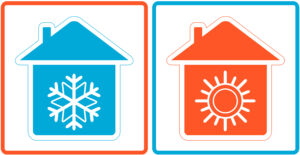
The heat pump is a nifty invention based on a simple principle: What if you could cause an air conditioning system to run in reverse, so instead of removing heat from the indoor air and blowing it outside, it would remove heat from the outside air and blow it indoors. Presto! The air conditioner changes from cooling to heating.
Although it may be a simple concept, heat pumps need to have several special components built into them to allow them to shift from cooling a home to heating it. Below we’re going to look at the parts of a heat pump that make it different from an AC, the parts that let it work as both an air conditioner and a heater.
The Reversing Valve
This is the fundamental part of a heat pump that makes it different from an AC. For a heat pump to work in both cooling and heating modes, it needs to be able to change the direction that its refrigerant circulates. The reversing valve does this job.
As high-pressure refrigerant exits the compressor, it enters the reversing valve. Depending on how the valve is set, it will either direct the refrigerant toward the outdoor coil (cooling mode) or the indoor coil (heating mode). Reversing valves can wear down with time, so a common heat pump repair in Akron, OH is replacing the valve.
The Suction Line Accumulator
A heat pump can’t just slam refrigerant in a different direction when it switches from mode to mode. There’s a danger of liquid refrigerant flowing back into the compressor when it changes direction. This condition (called slugging) can rapidly ruin a compressor.
The suction line accumulator is the part of a heat pump that prevents slugging. The accumulator stores excess refrigerant that might flow back into the compressor while the heat pump is in heating mode. (Yes, a heat pump runs on less refrigerant when in heating mode.)
The Defrost Controls
People who get their first heat pump are often confused about how it’s able to run during the winter. Where is the heat coming from on a cold day to warm up the inside of the house? But on even the coldest day, there’s still heat energy in the air.
Only one thing might hold back a heat pump in winter, and that’s frost along its coils. As the outdoor coil absorbs heat, it also collects water moisture. If the temperature outside is below freezing, that moisture will turn to ice and start making it harder for the heat pump to work.
But heat pumps have a built-in defense against this: the defrost controls. These controls shift the direction of refrigerant when in heating mode so the coils briefly release heat and melt the ice. The defrost controls then return to standard heating mode.
Extra Pressure Relief Valves
The AC uses a pressure relief valve to expand the warm refrigerant heading toward the indoor coil, causing its temperature to drop below freezing. Because a heat pump has to handle refrigerant moving in two different directions, it has a second pressure relief valve.
There are several other differences, such as how the control board works, but these are the major parts to know about your heat pump. If you ever need one of these parts, or any part, repaired, leave the work to us!
Reach out to Crown Group Ohio—Your Comfort Experts Since 1963.
